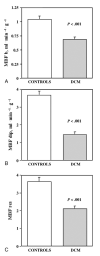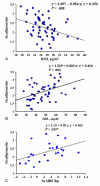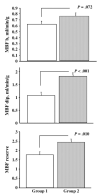Adiponectin is associated with abnormal lipid profile and coronary microvascular dysfunction in patients with dilated cardiomyopathy without overt heart failure
- PMID: 20199784
- PMCID: PMC3706193
- DOI: 10.1016/j.metabol.2009.12.030
Adiponectin is associated with abnormal lipid profile and coronary microvascular dysfunction in patients with dilated cardiomyopathy without overt heart failure
Abstract
Reduced plasma adiponectin has been associated with abnormal lipid profile, reduced left ventricle (LV) function, and the extent of coronary atherosclerosis in coronary artery disease. The aim of this study was to assess these relationships in patients with dilated cardiomyopathy (DCM) without overt heart failure. Plasma adiponectin was measured in 55 DCM patients (age, 59 ± 12 years; male, 36; body mass index [BMI], 26.9 ± 0.49 kg/m²; LV ejection fraction, 39.8% ± 1.3%; New York Heart Association class I-II) and in 40 age- and BMI-matched healthy controls. In a subset of 25 patients, myocardial blood flow (MBF) was measured at rest and during intravenous dipyridamole (0.56 mg/kg in 4 minutes) by positron emission tomography and ¹³N-ammonia as a flow tracer. Adiponectin was 6.6 ± 0.34 μg/mL in controls and 10.9 ± 0.85 μg/mL in DCM patients (P < .001), where it was related inversely with BMI (P = .009) and directly with brain natriuretic peptide (P = .017), high-density lipoprotein (HDL) cholesterol (P = .002), and MBF dipyridamole (P = .020). Adiponectin lesser than median value in patients was associated with higher total to HDL cholesterol ratio (4.8 ± 0.24 vs 3.9 ± 0.18, P = .009) and lower MBF reserve (1.76 ± 0.16 vs 2.43 ± 0.19, P = .01). These results could suggest that down-regulation of the adiponectin levels and reduced HDL cholesterol have a key role in causing impaired coronary function and myocardial perfusion in DCM.
© 2011 Elsevier Inc. All rights reserved.
Figures



Similar articles
-
Myocardial blood flow response to pacing tachycardia and to dipyridamole infusion in patients with dilated cardiomyopathy without overt heart failure. A quantitative assessment by positron emission tomography.Circulation. 1995 Aug 15;92(4):796-804. doi: 10.1161/01.cir.92.4.796. Circulation. 1995. PMID: 7641359
-
Abnormal glucose and lipid control in non-ischemic left ventricular dysfunction.J Nucl Cardiol. 2012 Dec;19(6):1182-9. doi: 10.1007/s12350-012-9609-7. Epub 2012 Aug 10. J Nucl Cardiol. 2012. PMID: 22879076
-
Reduction of myocardial blood flow reserve in idiopathic dilated cardiomyopathy without overt heart failure and its relation with functional indices: an echo-Doppler and positron emission tomography study.J Cardiovasc Med (Hagerstown). 2008 Aug;9(8):778-82. doi: 10.2459/JCM.0b013e3282fa7007. J Cardiovasc Med (Hagerstown). 2008. PMID: 18607240
-
Cardiac PET imaging for the detection and monitoring of coronary artery disease and microvascular health.JACC Cardiovasc Imaging. 2010 Jun;3(6):623-40. doi: 10.1016/j.jcmg.2010.04.007. JACC Cardiovasc Imaging. 2010. PMID: 20541718 Review.
-
Coronary microvascular dysfunction: a key step in the development of uraemic cardiomyopathy?Heart. 2019 Sep;105(17):1302-1309. doi: 10.1136/heartjnl-2019-315138. Epub 2019 Jun 25. Heart. 2019. PMID: 31239278 Free PMC article. Review.
Cited by
-
High-density lipoprotein-mediated cardioprotection in heart failure.Heart Fail Rev. 2021 Jul;26(4):767-780. doi: 10.1007/s10741-020-09916-0. Heart Fail Rev. 2021. PMID: 31984450 Review.
-
Adiponectin Protects Hypoxia/Reoxygenation-Induced Cardiomyocyte Injury by Suppressing Autophagy.J Immunol Res. 2022 Oct 17;2022:8433464. doi: 10.1155/2022/8433464. eCollection 2022. J Immunol Res. 2022. PMID: 36300016 Free PMC article.
-
Circulating Omentin-1 Levels Are Decreased in Dilated Cardiomyopathy Patients with Overt Heart Failure.Dis Markers. 2016;2016:6762825. doi: 10.1155/2016/6762825. Epub 2016 May 24. Dis Markers. 2016. PMID: 27313334 Free PMC article.
-
Regional evidence of modulation of cardiac adiponectin level in dilated cardiomyopathy: pilot study in a porcine animal model.Cardiovasc Diabetol. 2012 Nov 19;11:143. doi: 10.1186/1475-2840-11-143. Cardiovasc Diabetol. 2012. PMID: 23164042 Free PMC article.
-
Longitudinal associations between adiponectin and cardiac structure differ by hypertensive status: Coronary Artery Risk Development in Young Adults.Cardiovasc Endocrinol. 2016 Jun;5(2):57-63. doi: 10.1097/XCE.0000000000000080. Cardiovasc Endocrinol. 2016. PMID: 27525195 Free PMC article.
References
-
- Hara K, Yamauchi T, Imai Y, et al. Reduced adiponectin level is associated with severity of coronary artery disease. Int Heart J. 2007;48:149–53. - PubMed
-
- Hashimoto N, Kanda J, Nakamura T, et al. Association of hypoadiponectinemia in men with early onset of coronary heart disease and multiple coronary artery stenoses. Metabolism. 2006;55:1653–7. - PubMed
-
- Frystyk J, Berne C, Berglund L, et al. Serum adiponectin is a predictor of coronary heart disease: a population-based 10-year follow-up study in elderly men. J Clin Endocrinol Metab. 2007;92:571–6. - PubMed
MeSH terms
Substances
Grants and funding
LinkOut - more resources
Full Text Sources
Medical
Miscellaneous

